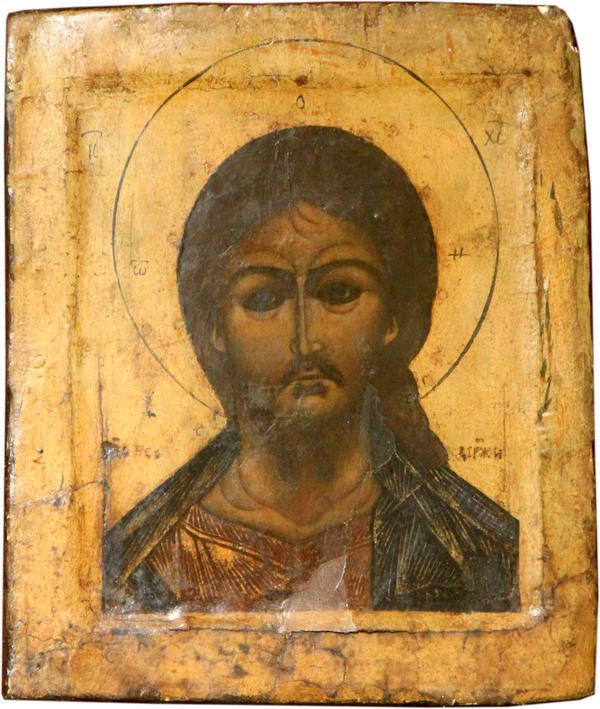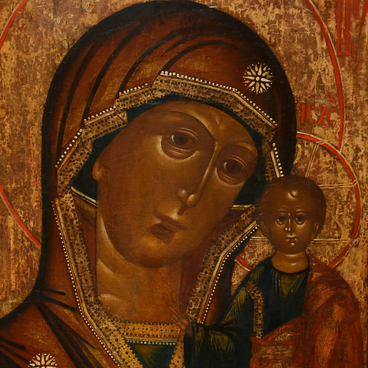In 1970, the icon of Christ Pantocrator (Saviour Shoulder Length) was transferred to the Museum of Local History of the Republic of Mordovia from the Museum of National Folk Architecture and Rural Life located in the village of Makarovka. The icon is titled Saviour Should Length as the depiction is reduced and Christ is shown from the shoulders up. This type of iconography came to Russia from the Byzantine Empire where it was very popular in the 14th century. In the Russian icon painting, the image of Saviour Shoulder Length appeared later, the majority of remained icons dated back to the 16th and 17th centuries.
Such icons often occupied the central position in the Deesis, a group of three images with Christ Pantocrator in the center franked by the Virgin Mary and St. John the Baptist. Shoulder tracings are outline drawings reproduced from icons of the 17th century and they can be found in Syisky book of icon painting prototypes, a collection of patterns of canonical images.
The manner of painting of Christ Pantocrator proves that the icon was copied from an original dated back to the 16th or 17th centuries. The head of Christ is painted in accordance with the classical scheme of Old Russian icon painting, color transitions (vokhrenya, ochre is the Russian word for ochre) are smooth and performed almost without white paint. However the icon of Christ Pantocrator is a copy and it can be testified by several typical features, such as sharp contours of lower eyelids, brow ridges, and collarbones as well as absence of highlights (fine white lines or ozhivki), which complete the depiction of a face and make it more expressive and vivid.
The head of Christ on the icon is slightly turned to the left, his glance is contemplative but sad, his lower lip is pressed, the face is sorrowful, thus, the image gives rise to the sense of bitterness and sympathy. Though Jesus Christ painted by an unknown artist is sad about people’s sins, he is forgiving, affectionate and merciful. Having looked at the icon for a long time, a person becomes humbled, forgets everyday life, and feels pacified and soothed.
Looking attentively at the icon, one can see that there is no cross inside the halo typical of the Saviour and the icon has no traditional contrast framing. It can be explained by the fact that Christ Pantocrator was initially painted to be used with a riza that covered background, frames and part of the halo. Such rizas were widely used in the 16th and 17th centuries and later among Old Believers who owned this icon. Traces of nails seen on photos taken when the icon was delivered to be restored proves this version.
Such icons often occupied the central position in the Deesis, a group of three images with Christ Pantocrator in the center franked by the Virgin Mary and St. John the Baptist. Shoulder tracings are outline drawings reproduced from icons of the 17th century and they can be found in Syisky book of icon painting prototypes, a collection of patterns of canonical images.
The manner of painting of Christ Pantocrator proves that the icon was copied from an original dated back to the 16th or 17th centuries. The head of Christ is painted in accordance with the classical scheme of Old Russian icon painting, color transitions (vokhrenya, ochre is the Russian word for ochre) are smooth and performed almost without white paint. However the icon of Christ Pantocrator is a copy and it can be testified by several typical features, such as sharp contours of lower eyelids, brow ridges, and collarbones as well as absence of highlights (fine white lines or ozhivki), which complete the depiction of a face and make it more expressive and vivid.
The head of Christ on the icon is slightly turned to the left, his glance is contemplative but sad, his lower lip is pressed, the face is sorrowful, thus, the image gives rise to the sense of bitterness and sympathy. Though Jesus Christ painted by an unknown artist is sad about people’s sins, he is forgiving, affectionate and merciful. Having looked at the icon for a long time, a person becomes humbled, forgets everyday life, and feels pacified and soothed.
Looking attentively at the icon, one can see that there is no cross inside the halo typical of the Saviour and the icon has no traditional contrast framing. It can be explained by the fact that Christ Pantocrator was initially painted to be used with a riza that covered background, frames and part of the halo. Such rizas were widely used in the 16th and 17th centuries and later among Old Believers who owned this icon. Traces of nails seen on photos taken when the icon was delivered to be restored proves this version.



